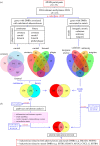In silico epigenetics of metal exposure and subclinical atherosclerosis in middle aged men: pilot results from the Aragon Workers Health Study
- PMID: 29685964
- PMCID: PMC5915723
- DOI: 10.1098/rstb.2017.0084
In silico epigenetics of metal exposure and subclinical atherosclerosis in middle aged men: pilot results from the Aragon Workers Health Study
Abstract
We explored the association of metal levels with subclinical atherosclerosis and epigenetic changes in relevant biological pathways. Whole blood DNA Infinium Methylation 450 K data were obtained from 23 of 73 middle age men without clinically evident cardiovascular disease (CVD) who participated in the Aragon Workers Health Study in 2009 (baseline visit) and had available baseline urinary metals and subclinical atherosclerosis measures obtained in 2010-2013 (follow-up visit). The median metal levels were 7.36 µg g-1, 0.33 µg g-1, 0.11 µg g-1 and 0.07 µg g-1, for arsenic (sum of inorganic and methylated species), cadmium, antimony and tungsten, respectively. Urine cadmium and tungsten were associated with femoral and carotid intima-media thickness, respectively (Pearson's r = 0.27; p = 0.03 in both cases). Among nearest genes to identified differentially methylated regions (DMRs), 46% of metal-DMR genes overlapped with atherosclerosis-DMR genes (p < 0.001). Pathway enrichment analysis of atherosclerosis-DMR genes showed a role in inflammatory, metabolic and transport pathways. In in silico protein-to-protein interaction networks among proteins encoded by 162 and 108 genes attributed to atherosclerosis- and metal-DMRs, respectively, with proteins known to have a role in atherosclerosis pathways, we observed hub proteins in the network associated with both atherosclerosis and metal-DMRs (e.g. SMAD3 and NOP56), and also hub proteins associated with metal-DMRs only but with relevant connections with atherosclerosis effectors (e.g. SSTR5, HDAC4, AP2A2, CXCL12 and SSTR4). Our integrative in silico analysis demonstrates the feasibility of identifying epigenomic regions linked to environmental exposures and potentially involved in relevant pathways for human diseases. While our results support the hypothesis that metal exposures can influence health due to epigenetic changes, larger studies are needed to confirm our pilot results.This article is part of a discussion meeting issue 'Frontiers in epigenetic chemical biology'.
Keywords: DNA methylation; cohort study; environmental metals; subclinical atherosclerosis.
© 2018 The Author(s).
Conflict of interest statement
We declare we have no competing interests.
Figures


Similar articles
-
Toxic Metals and Subclinical Atherosclerosis in Carotid, Femoral, and Coronary Vascular Territories: The Aragon Workers Health Study.Arterioscler Thromb Vasc Biol. 2022 Jan;42(1):87-99. doi: 10.1161/ATVBAHA.121.316358. Epub 2021 Dec 9. Arterioscler Thromb Vasc Biol. 2022. PMID: 34879710
-
Identification of differentially methylated BRCA1 and CRISP2 DNA regions as blood surrogate markers for cardiovascular disease.Sci Rep. 2017 Jul 11;7(1):5120. doi: 10.1038/s41598-017-03434-0. Sci Rep. 2017. PMID: 28698603 Free PMC article.
-
Association of global DNA methylation and global DNA hydroxymethylation with metals and other exposures in human blood DNA samples.Environ Health Perspect. 2014 Sep;122(9):946-54. doi: 10.1289/ehp.1306674. Epub 2014 Apr 25. Environ Health Perspect. 2014. PMID: 24769358 Free PMC article.
-
Arsenic exposure and human blood DNA methylation and hydroxymethylation profiles in two diverse populations from Bangladesh and Spain.Environ Res. 2022 Mar;204(Pt B):112021. doi: 10.1016/j.envres.2021.112021. Epub 2021 Sep 10. Environ Res. 2022. PMID: 34516978 Free PMC article.
-
Metals in urine in relation to the prevalence of pre-diabetes, diabetes and atherosclerosis in rural India.Occup Environ Med. 2018 Sep;75(9):661-667. doi: 10.1136/oemed-2018-104996. Epub 2018 Apr 19. Occup Environ Med. 2018. PMID: 29674487
Cited by
-
[Environment and cardiovascular health: causes, consequences and opportunities in prevention and treatment].Rev Esp Cardiol. 2022 Dec;75(12):1050-1058. doi: 10.1016/j.recesp.2022.05.022. Epub 2022 Jul 8. Rev Esp Cardiol. 2022. PMID: 36570815 Free PMC article. Spanish.
-
Lipid Phenotypes and DNA Methylation: a Review of the Literature.Curr Atheroscler Rep. 2021 Sep 1;23(11):71. doi: 10.1007/s11883-021-00965-w. Curr Atheroscler Rep. 2021. PMID: 34468868 Free PMC article. Review.
-
The association of urine metals and metal mixtures with cardiovascular incidence in an adult population from Spain: the Hortega Follow-Up Study.Int J Epidemiol. 2019 Dec 1;48(6):1839-1849. doi: 10.1093/ije/dyz061. Int J Epidemiol. 2019. PMID: 31329884 Free PMC article.
-
Prenatal Arsenic Exposure and Gene Expression in Fetal Liver, Heart, Lung, and Placenta.bioRxiv [Preprint]. 2024 Nov 11:2024.11.10.622821. doi: 10.1101/2024.11.10.622821. bioRxiv. 2024. PMID: 39605375 Free PMC article. Preprint.
-
Impacts of Environmental Insults on Cardiovascular Aging.Curr Environ Health Rep. 2022 Mar;9(1):11-28. doi: 10.1007/s40572-022-00335-x. Epub 2022 Feb 1. Curr Environ Health Rep. 2022. PMID: 35103958 Review.
References
Publication types
MeSH terms
Substances
Associated data
Grants and funding
LinkOut - more resources
Full Text Sources
Other Literature Sources
Medical

